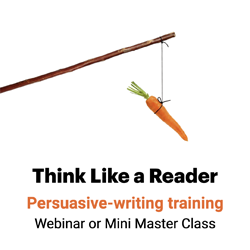Avoid losing readers with these 4 steps
Fear appeals persuade. But they can also paralyze.

Strong fear appeals persuade … The stronger the fear appeal, the more likely it is to move your readers to act, according to 50 years of research and 100 studies reviewed by researchers Kim Witte and Mike Allen.
In fact, a well-designed fear appeal should move about 4% of your target audience to act. So if you have 10,000 readers, 400 of them should change their behavior.
Weak fear appeals, on the other hand, don’t move audience members act.
… But they also paralyze. However, write Noah J. Goldstein, Steve J. Martin and Robert B. Cialdini in Yes!: 50 Scientifically Proven Ways to Be Persuasive, when you arouse fear without clearly showing how readers can reduce the danger, they may deal with the fear by blocking out the message.
To create a message that persuades your audience without paralyzing them, structure your fear appeal in four parts:
1. Introduce the threat.
The stronger the threat, the more effective the fear appeal. So:
A. Demonstrate the severity of the threat. Professional money managers, for instance, might reach out to trustees with a fear appeal like this:
“Individual trustees who are managing trusts on their own — even those who have appointed an investment advisor in a traditional trust arrangement — are personally responsible to the trust for the performance of those assets.”
B. Describe the threat using vivid word pictures. Illustrate the horrible consequences of the threat, as in this image from the World Wildlife Fund:
“Imagine (a group of dolphins) accidentally entangled in a fishing net, struggling for every single breath as they try to thrash their way to safety.”
C.Pile on references to the threat. Here’s how the Natural Resources Defense Council does it:
… The last gasp of a polar bear before it drowns in the vast waters of the Arctic, unable to reach the increasingly distant ice floes it needs to find food.
… The muffled cries of newborn polar bear cubs as they are buried alive when their snowy den collapses from unseasonable rains.
… The exhaustion of a mother polar bear and her young as they succumb to starvation after enduring longer and longer periods without food.
The stronger the threat, the more effective it will be.
2. Demonstrate that the reader is at risk.
The more personal the threat, the more effective the fear appeal.
Teenagers, for instance, are likely to be more afraid of bad breath than of cancer from smoking, says researcher Herbert J. Rotfeld. That’s because teens don’t feel personally threatened by mortality; they think it’s something old people get.
For parents who smoke, on the other hand, the strongest fear appeal might be that their children are likely to imitate their parents’ behavior.
So personalize the message. To make your fear appeals more relevant to your readers:
A. Focus on your audience’s risk of the threat. Here’s an example, from Northern Fund’s marketing magazine:
Women are particularly likely to live in poverty in old age: Regardless of their current incomes, one-third to two-thirds of 25- to 55-year-old women could become destitute if they don’t start to prepare for their financial futures now.
B. Emphasize similarities between victims of the threat and the target audience:
Like you, these women had high-paying jobs in their 40s and 50s.
C. Personalize the threat. Bring it home to the reader.
Bottom line: If you’re a woman, you face a 33% chance of living in poverty after you retire.
Avoid the breaking point.
At this point, readers make a decision. If they find the threat irrelevant or insignificant, they’ll ignore your message.
But if they feel susceptible to a serious threat, they’ll start wondering what they can do about it.
That makes this the perfect time to introduce the solution.
3. Demonstrate the effectiveness of the solution.
In one Australian study, researchers found that the audience’s view of the solution outweighed the importance of the threat in the success of a fear appeal.
Call it “response efficacy” — researchers’ term for whether a person believes the solution will actually reduce the risk.
Here’s how it works:
- I believe a biochemical terrorist attack is a real, severe risk. [Severity of threat.]
- I believe I am at risk. [Personalize the risk.]
- But I don’t believe that putting duct tape around my windows is an effective solution. So I opt out. [Effectiveness of solution.]
So don’t blow this off with a one-liner: Develop this section as well as you develop the threat. Outline how, why and when the solution will reduce the risk.
4. Show that readers can perform the solution.
If readers think the solution won’t work or that they can’t implement the solution, they’ll feel it’s futile to try to control the risk.
Then they’ll focus on controlling their fear instead of the threat. They may become defensive: “This is freaking me out. I’m not going to think about it.”
For instance:
- I believe that the cost of spending years in a nursing home can devastate a family’s finances. [Severity of threat]
- I believe my own family’s finances are at risk. [Personal risk]
- I believe that long-term-care insurance would be an effective solution. [Effectiveness of solution]
- I just don’t see how I could afford long-term-care insurance premiums. [My ability to perform solution.]
So demonstrate that your action recommendations are cheap, painless and easy to implement. “Lose 40 pounds,” for instance, isn’t easy. “Substitute a liquid meal replacement for one meal a day” is more achievable.
How can you use this model to develop a four-part fear appeal that persuades, rather than paralyzing, readers.
____
Sources: Noah J. Goldstein, Steve J. Martin and Robert B. Cialdini; Yes!: 50 Scientifically Proven Ways to Be Persuasive, Free Press, 2009
Kim Witte and Mike Allen, “A Meta-Analysis of Fear Appeals: Implications for Effective Public Health Campaigns,” Health Education & Behavior, October 2000
Herbert J. Rotfeld, “There are threats and (maybe) fear-caused arousal: theory and confusions of appeals to fear and fear arousal itself,” Journal of Advertising, Sept. 22, 1997
Richard Tay, Barry Watson and Olivia Radbourne, “The influence of fear arousal and perceived efficacy on the acceptance and rejection of road safety advertising message,” Road Safety Research, Policing and Education Conference (Regain the Momentum), Melbourne, 2001

Leave a Reply